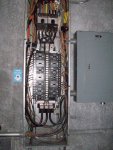HenryM
Member
- Location
- Fresno, CA
Could someone point to a section in the NEC, if any, that disallows any foreign object inside a Panel. I found a Panel (see attached) where a foreign object was used to tie down a spliced connection inside. It looks like the contractor miscalculated on the length of the cable going to this Panel. Parallel 3/0 was spliced to a 500MCM cable in order to get to the main lugs below. In order to hold the cables in place, a wood (which was subsequently removed) and a piece of plastic was taped to the splice to hold it in place when mounting the panel cover. I believe several other code violations can be found in the picture. The Panel is rated 480/277V, 400A, 3-phase, 4-wire.


